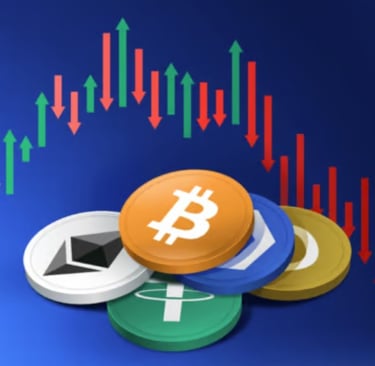The crypto market: Bitcoin's strength contrasting with struggles in altcoins, and specifically why XRP might be underperforming.
Blog post description.
NEWSTECHNOLOGY & CRYPTOOTHER NEWS
7/25/20253 min read


The crypto market: Bitcoin's strength contrasting with struggles in altcoins, and specifically why XRP might be underperforming.
Bitcoin's Price Rise: Multiple Tailwinds
Bitcoin (BTC) is experiencing a price surge due to several converging factors:
Institutional Adoption: This is a major driver. The approval of spot Bitcoin Exchange-Traded Funds (ETFs) in the US has opened the floodgates for traditional institutional investors to gain exposure to Bitcoin.1 These ETFs buy actual BTC, directly increasing demand.2 Companies like Strategy (formerly MicroStrategy) are also continuing to accumulate significant amounts of Bitcoin, reinforcing institutional confidence.3
"Crypto Week" and Regulatory Clarity: Recent legislative efforts in the US, such as the CLARITY Act, Anti-CBDC Surveillance Act, and the GENIUS Act, are being seen as positive steps towards a more robust and clear regulatory framework for cryptocurrencies.4 Reduced regulatory uncertainty can attract more traditional capital and reduce perceived risk in the market.
Crisis of Confidence in Traditional Currencies/Store of Value Narrative: In times of economic uncertainty or concerns about inflation and the US dollar's stability, Bitcoin often gains traction as a perceived "digital gold" or a store of value. Its fixed supply (21 million coins) and deflationary halving events (like the one in April 2024) contribute to this narrative of scarcity, which can drive up its price when demand increases.5
Supply and Demand Dynamics: Bitcoin's limited and predictable supply, combined with increasing demand from both retail and institutional investors, naturally pushes its price upward.6 When demand outpaces the rate at which new bitcoins are mined, the price climbs.
Macroeconomic Factors: While not explicitly stated as a direct cause for this current rise, general economic conditions and interest rate policies can influence investor appetite for risk assets like crypto. A more dovish stance from central banks or increased liquidity in the broader financial markets can often benefit Bitcoin.
XRP's Drop: Specific Headwinds and Market Dynamics
XRP, on the other hand, is facing its own set of challenges, leading to its price decline:
SEC Uncertainty and Delays: The ongoing legal battle between Ripple (the company behind XRP) and the U.S. Securities and Exchange Commission (SEC) is a significant overhang. While there have been some favorable rulings for Ripple, the uncertainty surrounding the SEC's appeal deadline (August 15th) and the lack of clarity on XRP-spot ETF approvals are making investors cautious. Delays in these approvals mean XRP isn't benefiting from the same institutional inflows seen by Bitcoin (and recently Ethereum) ETFs.
Cooling Open Interest and Technical Indicators: Reports indicate a decline in XRP futures contract Open Interest (OI) and a drop in the Relative Strength Index (RSI) from overbought conditions.7 This suggests a decrease in buying pressure and a potential shift towards bearish sentiment, possibly due to profit-taking after its recent highs.
Large Wallet Transfers (Co-Founder Selling): Recent substantial transfers of XRP from wallets linked to Ripple co-founder Chris Larsen (e.g., a $175 million transfer of 50 million XRP) can trigger sell-off fears. 8When a large holder moves a significant amount of tokens, the market often interprets it as a potential sale, increasing selling pressure.
Liquidations: The sharp drop in XRP has led to significant liquidations of long positions (bets that the price would go up).9 These forced sales further accelerate the price decline.
Broader Altcoin Market Sentiment (to some extent): While Bitcoin is often seen as a safe haven or leading indicator, if sentiment turns negative for specific altcoins, they can drop even if Bitcoin is performing well.
Why the Altcoin Rally is Under Threat (Broader Context)
While Bitcoin is strong, the overall altcoin rally (where many altcoins see significant gains) can be under threat due to:
Bitcoin Dominance: When Bitcoin's price rises sharply, it can sometimes pull capital away from altcoins. Investors might consolidate their holdings into BTC, or new capital might flow directly into Bitcoin, increasing its market dominance. While some analysts believe a declining Bitcoin dominance signals an altcoin season, a sustained surge in BTC can sometimes overshadow altcoins.
Regulatory Uncertainty for Specific Altcoins: Beyond Bitcoin, many altcoins still face significant regulatory ambiguity. The SEC's actions and potential classifications of various altcoins as securities can create fear and uncertainty, deterring investment.
Profit-Taking and Rotation: After periods of strong altcoin performance, investors often take profits and rotate funds back into more stable assets like Bitcoin or even out of crypto entirely.
Lack of Clear Use Cases and Fundamentals: Many altcoins lack strong, real-world utility or robust tokenomics. While speculative rallies can occur, sustained growth often requires tangible adoption and development. If projects fail to deliver on their promises, investor confidence wanes.
Liquidity and Volatility: Altcoin markets are generally smaller and less liquid than Bitcoin's, making them more susceptible to larger price swings from relatively smaller trading volumes or "whale" activity (large holders selling off).10
Competition: The altcoin space is highly competitive. Thousands of projects vie for investor attention and capital. Projects with better technology, stronger communities, and clearer roadmaps tend to outperform, while others struggle or fail.
In summary, Bitcoin's current strength is driven by institutional adoption, regulatory progress, and its store-of-value narrative. XRP's struggles are more specific, tied to its ongoing legal battle, technical indicators, and large transfers. The broader altcoin rally faces threats from Bitcoin's dominance, ongoing regulatory uncertainty, profit-taking, and the inherent volatility and speculative nature of many smaller cap projects.
